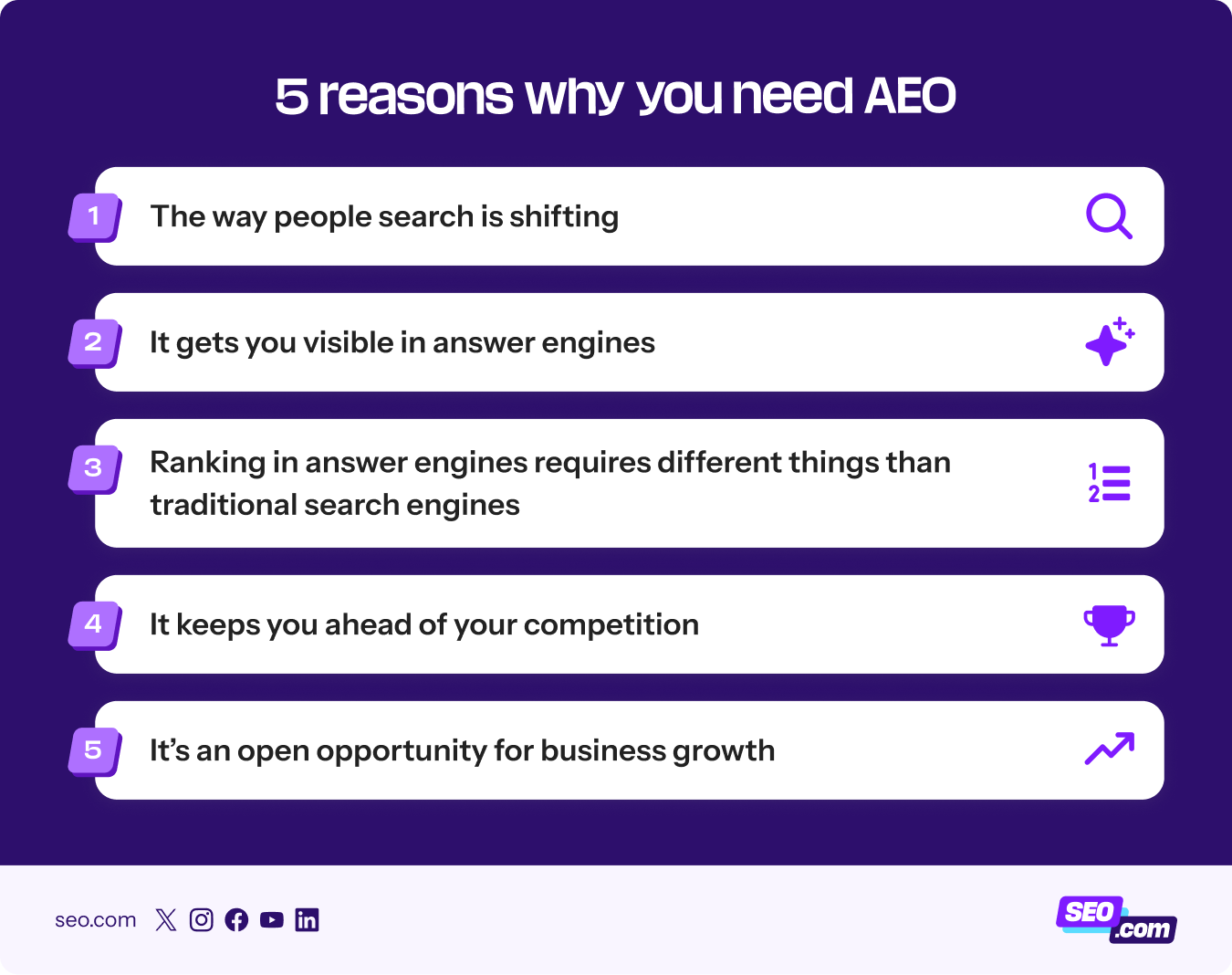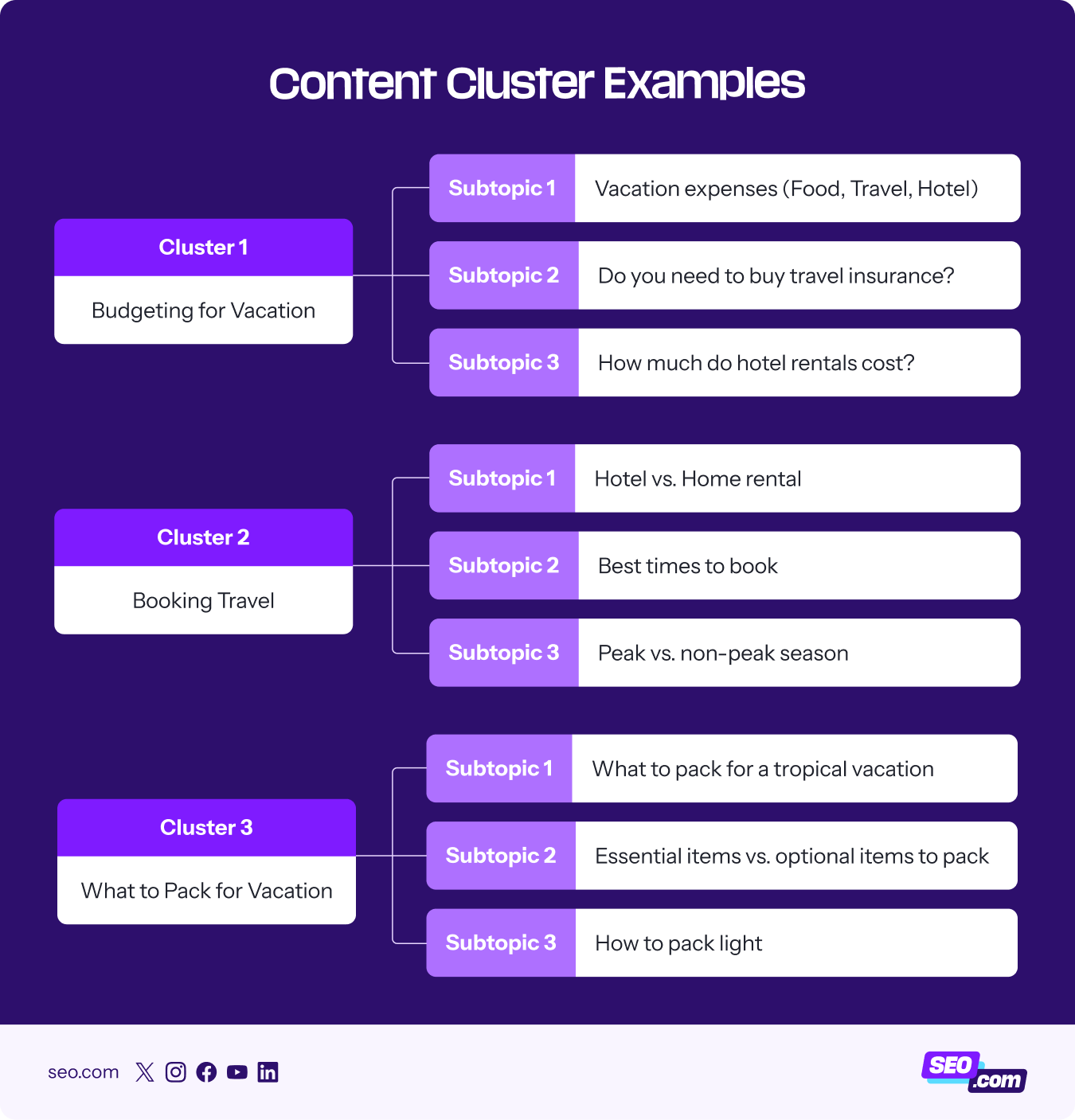No matter if you’re a marketing professional, business owner, or somewhere in between, you’ve been hearing about the shift in search. Answer engines are altering how and where people search for information. Hence, the birth of the newest jargony term: Answer Engine Optimization (AEO).
But like many companies, you’re probably wondering, “Do I need AEO? Do I need to develop a strategy?”
In short, yes.
AI is shifting the way people search, which means you need a strategy that accounts for this shift. And unfortunately, SEO alone won’t cut it.
Let’s dive into why you need AEO and how you can develop an AEO strategy that’s simple, effective, and helps you stay ahead.
5 reasons why you need AEO

If you’re on the fence about whether you need to invest in AEO, I’m here to tip the scales: Investing in an AEO strategy is the smart move if you’re reliant on search to drive traffic, leads, and conversions for your business.
Here’s why:
1. The way people search is shifting
People aren’t just using Google to find answers to their queries. They’re turning to answer engines like ChatGPT, Gemini, and Perplexity for answers. While these users aren’t abandoning Google completely, they are consulting these answer engines for information, so if you aren’t appearing in them, you’re missing out.
So, why the sudden shift in search?
The reality is that answer engines do something that traditional search engines didn’t do: synthesize information. Instead of having to open 2–3 blue links and scan through content to get an answer, users can type in a query and get a synthesized response that tells them what they need to know.
On top of that, the younger generation is propelling the change even further. For Gen Z, up to 31% of their searches are on an answer engine like ChatGPT. So, as time goes on, answer engines will continue to get more popular as the younger generation continues adopting them.
All of that to say, people are searching through different mediums than traditional search engines, which is why you need AEO to reach them.
2. It gets you visible in answer engines
Leveraging AEO enables you to appear in answer engines. AEO is specifically tailored to getting your brand to appear in search results when people use these answer engines. While, just like SEO, it’s not foolproof, it does increase your ability to appear in answer engines.
That leads to the next point.
3. Ranking in answer engines requires different things than traditional search engines
As I mentioned earlier, just doing traditional SEO isn’t enough to appear in answer engines. While a lot of basic SEO best practices can (and do) apply to answer engines, there are some modifications and enhancements that need to be done to make it work — hence the creation of AEO.
When you conduct a search on Google, you’re using short phrases to communicate what you’re looking for. For example, if you wanted to find somewhere to vacation for cheap, you’d search something like “cheap vacation destinations” or “best budget vacation destinations.”
So, with traditional SEO, you’d target those phrases in your content to help you reach the right audience.
But on answer engines, it’s different.
People aren’t just searching phrases. They’re searching full questions or with multiple sentences to get what they need.
So, someone may search “What are the best cheap vacation destinations?”
Or, they may be more elaborate and search something like this: “I want to take a cheap vacation this year. My budget is $X–$X. It will be for two adults and one child. I’d like to travel somewhere warm. I’m looking for family-friendly activities at the destination, too. Can you make some recommendations?”
As you can see, the way people search on answer engines is different from traditional engines, hence the need for an AEO strategy.
4. It keeps you ahead of your competition
Right now, you have competitors out there that aren’t thinking about AEO or don’t think they need it. But you’re already looking into it, which means you have the early mover advantage. You can start implementing an AEO strategy and get ahead of your competition.
The reality is, answer engines aren’t going anywhere. You can opt to ignore them and think they’ll go away, but they won’t — they’re now an integral part of the way people search.
Over 15 million people in the U.S. used AI engines first for an online search in 2024, with that number expected to hit 36 million by 2028.
That means millions of people will turn to answer engines like ChatGPT, Claude, and Perplexity first before going to Google.
So, while your competitors are wondering why their search traffic is dropping or scrambling to figure out AEO, you’ll be set and already appearing in answer engine responses.
5. It’s an open opportunity for business growth
Answer engines are a channel of untapped potential. People are either still figuring out how to optimize for these engines, or they’re ignoring optimizing for them. That means there’s a lot of opportunity for business growth if you start building an AEO strategy now.
If you get your strategy going now, you can start optimizing for these searches and drive traffic and leads from these answer engines.
Okay, I need an AEO strategy. Where do I start?
If you’re thinking an AEO strategy is a good move for you, I’ve got some tactics you can put into action to do AEO.
1. Provide clear, concise answers to questions
The function of answer engines is to provide, well, answers. But not just any answers — succinct, concise, and helpful answers. They don’t dish out paragraphs of fluff before getting to the good stuff.
So, if you want to do AEO right, provide clear and concise answers to any questions you’re targeting on your website. It will help you have a better chance of appearing in LLM results.
2. Build content clusters
There are two things to know about LLMs:
- They consult multiple sources to answer user queries
- They don’t just answer the original query — they try to anticipate what the searcher will need and provide that information too.
Knowing that information, creating content clusters is a great idea. Content clusters are pages that build on one core topic.
Here’s an example:

This is just a basic example of how you could build a content cluster around the topic. But, as you can see, you’re covering information on multiple topics surrounding things people might search for when planning a vacation.
So now, if someone searches something like “I want to budget for a vacation. What do I need to account for in my budget? I know I’m going to rent a hotel room, so can you factor in the average cost a night for that. My plan is to stay for 4 nights.” You have multiple pieces of content addressing that topic, which can help increase your chances of being cited.
3. Use structured data
Structured data is a must for AEO. This data, also known as schema markup, is crucial for providing all types of search engines with context about your page. Schema tells engines more about what’s on your page, so they can understand the relevancy.
Here are some types of structured data you can use:
- Article
- Local Business
- Organization
- Product
- FAQ
- Video
- HowTo
- Review
If you want to learn more about how you can add this structured data, check out our blog post on how to add schema markup.
4. Take a user-focused approach to formatting pages
Answer engines, much like users, want clean pages that are easy to navigate and find information on. Creating a user-focused experience with your pages will help you have a better chance of appearing in answer engines.
Follow best practices like:
- Using bulleted lists to break down information
- Breaking content down into relevant headings and subheadings
- Adding FAQs to address any additional questions
- Using simple language and avoiding heavy jargon
Get started with AEO today
Establishing your AEO strategy now will greatly benefit for your business in the years to come. Answer engines will only continue to grow in popularity, so having an established strategy now will set your business up for success.
If you need help launching a successful AEO strategy, WebFX (the team behind SEO.com) can help you do it. Check out our AEO services to see what we can do for you!

Future-Proof Your SEO Strategy with OmniSEO®
Goodbye search engine optimization, hello search everywhere optimization.



Future-Proof Your SEO Strategy with OmniSEO®
Goodbye search engine optimization, hello search everywhere optimization.
Table of Contents
- 5 Reasons Why You Need AEO
- 1. The Way People Search is Shifting
- 2. It Gets You Visible in Answer Engines
- 3. Ranking in Answer Engines Requires Different Things Than Traditional Search Engines
- 4. It Keeps You Ahead of Your Competition
- 5. It’s an Open Opportunity for Business Growth
- Where Should I Start when Developing an AEO Strategy?

Future-Proof Your SEO Strategy with OmniSEO®
Goodbye search engine optimization, hello search everywhere optimization.



